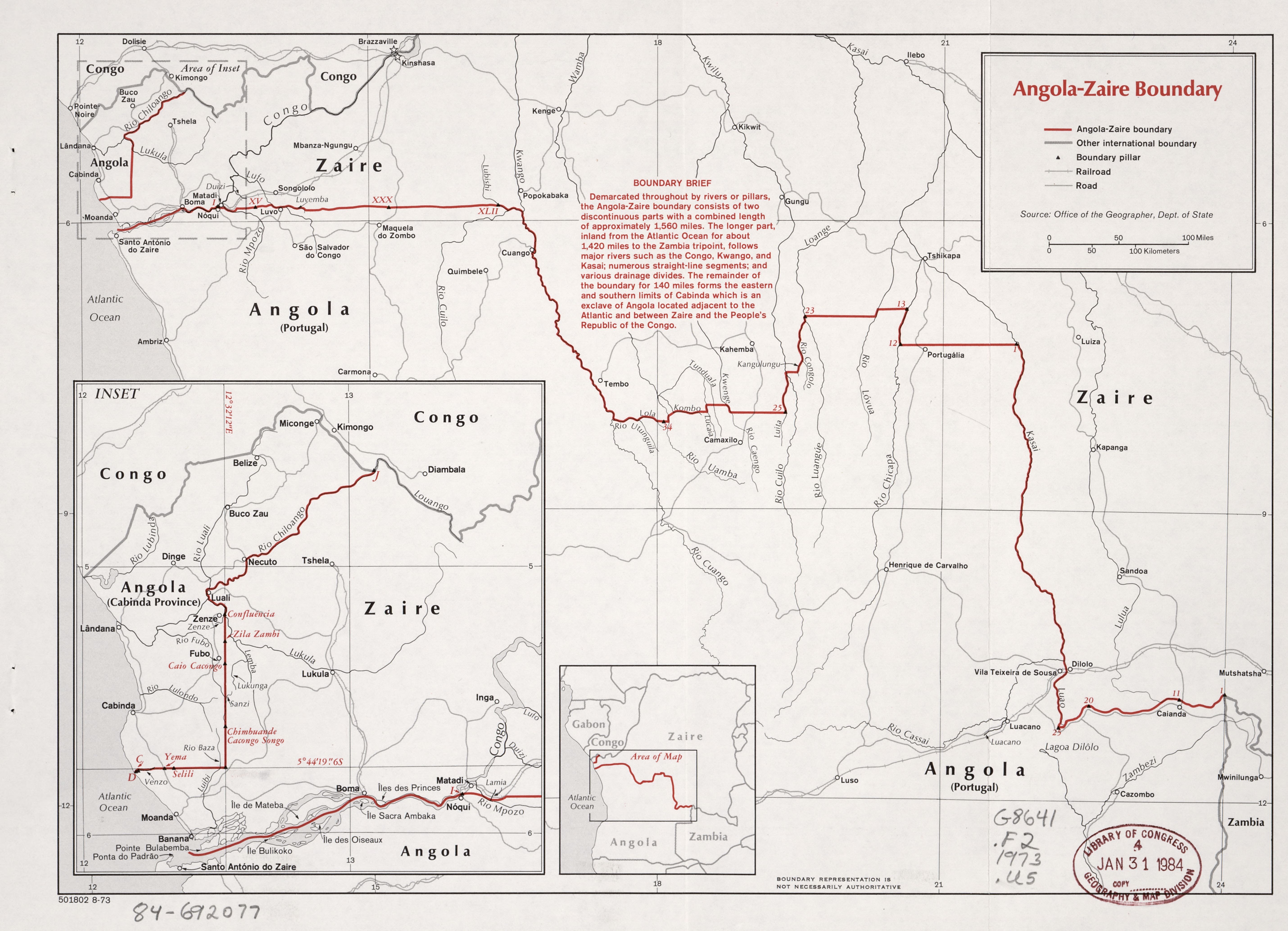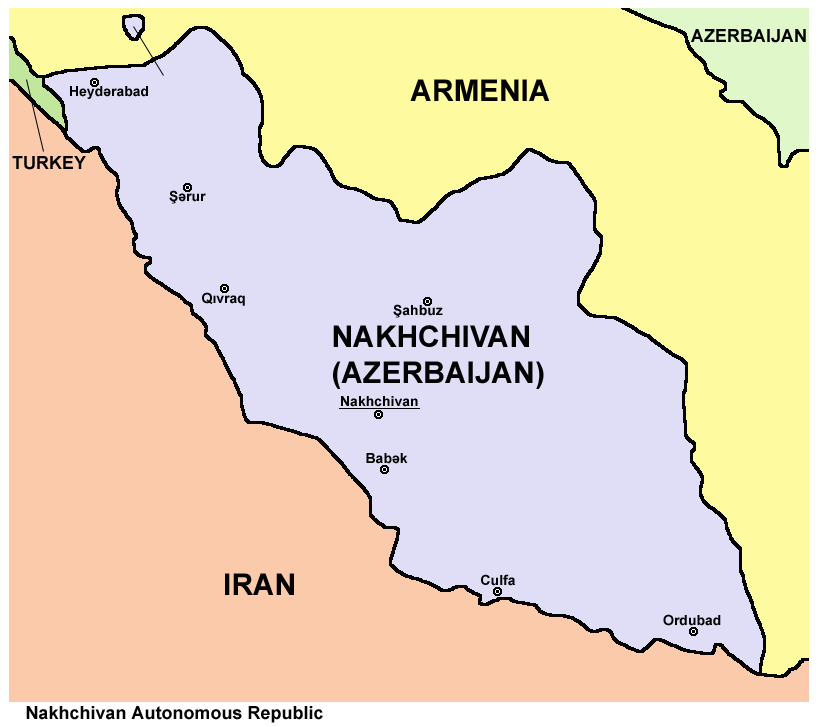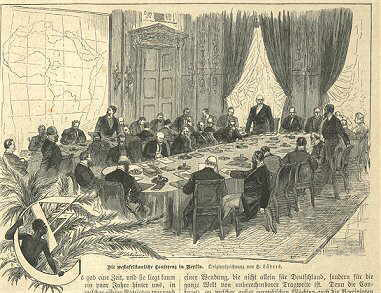|
Angola–Democratic Republic Of The Congo Border
The Angola–Democratic Republic of the Congo border is 2,646 km (1,644 mi) in length and consists of two non-contiguous sections: a 225 km (140 mi) section along the border with Angola's province of Cabinda, running from the Atlantic Ocean to the tripoint with the Republic of Congo, and a much longer 2,421 km (1,504 mi) section running from the Atlantic to the tripoint with Zambia. Description Northern (Cabinda) section The border starts in the west on the Atlantic coast, proceeding to the north-east by an irregular and then a straight line, before turning to the north where it then proceeds in a straight line up to Luali river. The border then follows this river north to the confluence with the Chiloango, then following the latter as it flows to the north-east up the tripoint with the Republic of Congo. Southern section The border starts in the west on the Atlantic Coast at the estuary of the Congo River, following this river eastwards for a period before leavi ... [...More Info...] [...Related Items...] OR: [Wikipedia] [Google] [Baidu] |
Luao River
The Luao River forms part of the boundary between Angola and the Democratic Republic of the Congo. It is a right tributary of the Kasai River. Location The Luao River flows from south to north along the border between Moxico Province of Angola and Lualaba Province of the Democratic Republic of the Congo (DRC). It flows between the towns of Luau in Angola and Dilolo in the DRC. Border settlement The border agreement between Portugal and Belgium of 25 May 1891 defined part of the border as being a tributary of the Kasai up to Lago Dilolo. However, it was discovered that Lago Dilolo drained southeast into the Zambezi watershed rather than north to the Kasai. The Portuguese claimed that the Luao tributary of the Kasai should be taken as the boundary, while the Belgians were in favor of the Luacano River, a tributary of the Kasai farther to the west. Eventually Belgium ceded a large area west of the Luau River in an exchange of territories agreed on 22 July 1927. In return for the ... [...More Info...] [...Related Items...] OR: [Wikipedia] [Google] [Baidu] |
Belgian Congo
The Belgian Congo (, ; ) was a Belgian colonial empire, Belgian colony in Central Africa from 1908 until independence in 1960 and became the Republic of the Congo (Léopoldville). The former colony adopted its present name, the Democratic Republic of the Congo (DRC), in 1964. Colonization of the Congo Basin, Colonial rule in the Congo began in the late 19th century. Leopold II of the Belgians, King Leopold II of the Belgians attempted to persuade the Federal Government of Belgium, Belgian government to support colonial expansion around the then-largely unexploited Congo Basin. Their ambivalence resulted in Leopold establishing a colony himself. With support from a number of Berlin Conference, Western countries, Leopold achieved international recognition of the Congo Free State in 1885. By the turn of the century, the violence used by Free State officials against indigenous Congolese and a ruthless system of economic exploitation led to intense diplomatic pressure on Belgium to ... [...More Info...] [...Related Items...] OR: [Wikipedia] [Google] [Baidu] |
Dilolo
Dilolo is a town in Dilolo Territory, Lualaba province, Democratic Republic of the Congo. It lies within five miles of the eastern bank of the Luao River, the DRC-Angolan border, and the Angolan town of Luau, at an altitude of 3510 ft (1069 m). Transport Road The city is crossed by Trans-African Highway 9 (TAH 9), which connects it to the cities of Luau and Divuma. Rail The city has a train station, which receives trains from the Benguela railway The Benguela Railway () is a 3 ft 6 in gauge railways, Cape gauge railway line that runs through Angola from west to east, being the largest and most important railway line in the country. It also connects to Tenke, Democratic Republic of the C .... Airport The town is served by Dilolo Airport, and by Luau International Airport ( Luau, Angola) References Populated places in Lualaba Province {{DRCongo-geo-stub ... [...More Info...] [...Related Items...] OR: [Wikipedia] [Google] [Baidu] |
Matadi
Matadi is the chief sea port of the Democratic Republic of the Congo and the capital of the Kongo Central province, adjacent to the border with Angola. It had a population of 245,862 (2004). Matadi is situated on the left bank of the Congo River, from the mouth and below the last navigable point before the rapids that make the river impassable for a long stretch upriver. History Matadi was near the site of the state of Vungu, which was first mentioned in 1535 and was said to be destroyed in 1624. Matadi itself was founded by Sir Henry Morton Stanley in 1879. It was strategically important because it was the last navigable port going upstream on the Congo River; it became the furthest inland port in the Congo Free State. The construction of the Matadi–Kinshasa Railway (built between 1890 and 1898) made it possible to transport goods from deeper within Congo's interior to the port of Matadi, stimulating the city to become an important trading center. Portuguese and French We ... [...More Info...] [...Related Items...] OR: [Wikipedia] [Google] [Baidu] |
Exclave
An enclave is a territory that is entirely surrounded by the territory of only one other state or entity. An enclave can be an independent territory or part of a larger one. Enclaves may also exist within territorial waters. ''Enclave'' is sometimes used improperly to denote a territory that is only partly surrounded by another state. Enclaves that are not part of a larger territory are not exclaves, for example Lesotho (enclaved by South Africa), and San Marino and Vatican City (both enclaved by Italy) are enclaved sovereign states. An exclave is a portion of a state or district geographically separated from the main part, by some surrounding alien territory. Many exclaves are also enclaves, but an exclave surrounded by the territory of more than one state is not an enclave. The Azerbaijani exclave of Nakhchivan is an example of an exclave that is not an enclave, as it borders Armenia, Iran, and Turkey. Semi-enclaves and semi-exclaves are areas that, except for possessing ... [...More Info...] [...Related Items...] OR: [Wikipedia] [Google] [Baidu] |
Treaty Of Simulanbuco
The Treaty of Simulambuco was signed in 1885 by representatives of the Portuguese government and officials in the N'Goyo Kingdom. The agreement was drafted and signed in response to the Treaty of Berlin, which was an agreement between the colonizing European powers about how to divide up Africa. The long-established Portuguese, not wanting to miss out on the Scramble for Africa involving territories near its own old possessions, began to colonize deeper than the numerous trading ports it had controlled on the African coast since the early 16th century. In contrast to the violent struggles between the Portuguese and some native peoples in Mozambique, the colonization of Cabinda was peaceful. Portugal first claimed sovereignty over Cabinda in the February 1885 Treaty of Simulambuco, which gave Cabinda the status of a protectorate of the Portuguese Crown under the request of "the princes and governors of Cabinda". Article 1 of the treaty, states, "the princes and chiefs and thei ... [...More Info...] [...Related Items...] OR: [Wikipedia] [Google] [Baidu] |
Leopold II Of Belgium
Leopold II (9 April 1835 – 17 December 1909) was the second king of the Belgians from 1865 to 1909, and the founder and sole owner of the Congo Free State from 1885 to 1908. Born in Brussels as the second but eldest-surviving son of King Leopold I and Louise of Orléans, Queen Louise, Leopold succeeded his father to the Belgian throne in 1865 and reigned for 44 years until his death, the longest reign of a Belgian monarch to date. He died without surviving legitimate sons; the current king of the Belgians, Philippe of Belgium, Philippe, descends from his nephew and successor, Albert I of Belgium, Albert I. He is popularly referred to as the Builder King (, ) in Belgium in reference to the great number of buildings, urban projects and public works he commissioned. Leopold was the founder and sole owner of the Congo Free State, a private colonial project undertaken on his own behalf as a personal union with Belgium. He used Henry Morton Stanley to help him lay claim to the Cong ... [...More Info...] [...Related Items...] OR: [Wikipedia] [Google] [Baidu] |
Congo Free State
The Congo Free State, also known as the Independent State of the Congo (), was a large Sovereign state, state and absolute monarchy in Central Africa from 1885 to 1908. It was privately owned by Leopold II of Belgium, King Leopold II, the constitutional monarch of the Kingdom of Belgium. In legal terms, the two separate countries were in a personal union. The Congo Free State was not a part of, nor did it belong to, Belgium. Leopold was able to Colonization of the Congo Basin, seize the region by convincing other European states at the Berlin Conference on Africa that he was involved in humanitarian and philanthropic work and would not tax trade. Via the International Association of the Congo, he was able to lay claim to most of the Congo Basin. On 29 May 1885, after the closure of the Berlin Conference, the king announced that he planned to name his possessions "the Congo Free State", an appellation which was not yet used at the Berlin Conference and which officially replaced "I ... [...More Info...] [...Related Items...] OR: [Wikipedia] [Google] [Baidu] |
Berlin Conference
The Berlin Conference of 1884–1885 was a meeting of colonial powers that concluded with the signing of the General Act of Berlin,''The Belgian Congo and the Berlin act'' by Keith, Arthur Berriedale, 1919, p. 52. an agreement regulating European colonisation and trade in Africa during the period. The conference of fourteen countries was organised by |
Scramble For Africa
The Scramble for Africa was the invasion, conquest, and colonialism, colonisation of most of Africa by seven Western European powers driven by the Second Industrial Revolution during the late 19th century and early 20th century in the era of "New Imperialism": Belgian colonial empire, Belgium, French colonial empire, France, German colonial empire, Germany, British Empire, United Kingdom, Italian Empire, Italy, Portuguese Empire, Portugal and Spanish Empire, Spain. In 1870, 10% of the continent was formally under European control. By 1914, this figure had risen to almost 90%; the only states retaining sovereignty were Liberia, Ethiopian Empire, Ethiopia, Egba United Government, Egba, Sultanate of Aussa, Aussa, Senusiyya, Mbunda Kingdom, Mbunda, the Dervish State, the Darfur Sultanate, and the Ovambo people#History, Ovambo kingdoms, most of which were later conquered. The 1884 Berlin Conference regulated European colonisation and trade in Africa, and is seen as emblematic of t ... [...More Info...] [...Related Items...] OR: [Wikipedia] [Google] [Baidu] |
Kingdom Of Ndongo
The Kingdom of Ndongo (formerly known as Angola or Dongo, also Kimbundu: ) was an early-modern African state located in the highlands between the Lukala and Kwanza Rivers, in what is now Angola. The Kingdom of Ndongo is first recorded in the sixteenth century. It was one of multiple vassal states to Kongo, though Ndongo was the most powerful of these with a king called the '' Ngola''. Little is known of the kingdom in the early sixteenth century. "Angola" was listed among the titles of the King of Kongo in 1535, so it was likely somewhat subordinate to Kongo. Its oral traditions, collected in the late sixteenth century, particularly by the Jesuit Baltasar Barreira, described the founder of the kingdom, Ngola Kiluanje, also known as Ngola Inene, as a migrant from Kongo, chief of a Kimbundu-speaking ethnic group. Political structure The Kimbundu-speaking region was known as the land of Mbundu people. It was ruled by a ''Ngola'', or king, who lived with his extended fami ... [...More Info...] [...Related Items...] OR: [Wikipedia] [Google] [Baidu] |




